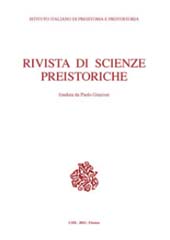Tecniche di sigillatura nell'età del Bronzo Recente italiana : indizi fittili dalla terramara di S. Rosa di Poviglio
P. 1-13
The careful examination of the clay findings collected during the extensive excavation of the Terramara of S. Rosa di Poviglio (Reggio Emilia, IT) led to the identification of several small objects that can be associated to sealing practices. These objects comprise two main typologies: cretulae and nodules. Cretulae are defined as small clay masses flattened by pressure, originally applied on more or less flat surfaces, bearing the imprints of vegetal or wooden items. In some cases, their upper surface shows evidence of the use of the fingers to press the clay against the item to be sealed. Nodules are elongated clay masses characterised by the presence of a through-hole left by the organic-matter cord they were once wrapped around. In some instances, the nodule preserves the negative impression of a knot that was englobed in the clay and fixed against a flat surface.
These items provide evidence for the habit of sealing containers and possibly doors using ropes that were then blocked by clay masses. Some of them were subject to accidental heating, which allowed their conservation to our days. The spatial distribution of these elements can tentatively be linked to the plan of the residential structures identified in the Villaggio Grande and thus illustrate the distribution of goods among the community. Their chronology indicates they started to be widely used at the start of the Recent Bronze Age (Bronzo Recente 1) and continued in a later phase of the same period (Bronzo Recente 2). These corresponds to the moment when the site remarkably grew in size and population.
While the original Middle Bronze Age core of the settlement only comprised the area of the Villaggio Piccolo, between the end of the Middle Bronze Age and the start of the Late Bronze Age, the Villaggio Grande was established just south of the former area. This entailed impressive land-movement works that in themselves would suggest the existence of some sort of centralised control, that might be mirrored in the introduction of the sealing system suggested here, functional to exert control on goods re-distribution when the site population grew to an unprecedented level. By presenting and briefly discussing the sealing elements from S. Rosa di Poviglio, this paper intends to prompt greater attention toward the nonceramic clay findings, usually mostly neglected during post-excavation works, highlighting their potential in the reconstruction of sealing practices and in the identification of the perishable materials of which they can preserve the imprint. [Publisher's text]
Fa parte di
Rivista di scienze preistoriche : LXXIV, 2024-
Articoli dello stesso fascicolo (disponibili singolarmente)
-
Informazioni
Codice DOI: 10.32097/1221
ISSN: 2282-457X
PAROLE CHIAVE
- Bronzo Recente, Sigillatura, Reperti fittili, Terramare
- Recent Bronze Age, Sealing techniques, Clay findings, Terramare


